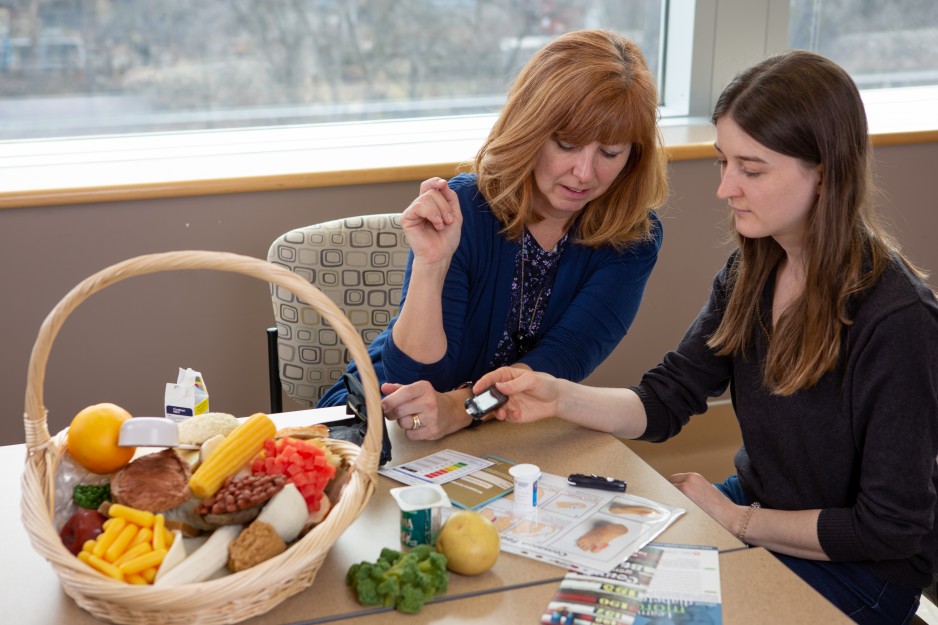Diabetic supplies or groceries – sometimes the choice is difficult
The gap between what people with diabetes need to manage their condition and what they can afford is a growing concern for the Diabetes Education Centre (DEC) team at St. Joseph’s Hospital.
A lack of funding for diabetes supplies, equipment and medications essential for evidence-based care means diabetes nurses and dietitians are spending much time helping patients navigate various avenues to secure financial support. To boost these advocacy efforts, St. Joseph’s recently launched a new service for diabetes patients. A registered social service worker is now available to provide coaching and guidance aimed at helping diabetes patients and their families find the resources they need for optimal self-care.
“The overall goal is to decrease barriers to care,” says Julie Hebert, social service worker. “This includes helping people with applications for financial support from various government agencies or advocating for coverage from private insurance companies.”
A significant stress
Many patients with type 1 and type 2 diabetes pay out thousands of dollars annually – a significant stress that adds to the physical and often mental health toll of diabetes,” says Rebecca Meehan, DEC registered nurse and educator. “It’s not uncommon for patients to be faced with choosing between recommended care and basic living expenses.”
For example, many of those without adequate coverage for test strips used for checking blood glucose levels forego checking, which leads to poorly managed diabetes and a higher risk of complications, says Rebecca.
Jason Howard estimates he pays about $4,000 a year out-of-pocket for diabetes-related essentials. Both he and his wife are self-employed, which means they can’t tap into private group insurance and don’t qualify for most of the government funding programs.
The 47-year-old, who has had to scale back his handyman business due to his health, admits to cutting corners as a way to ration supplies and medication, such as using the same needle for a week instead of a new one daily for insulin injection. And rather than changing the lancet each time he pricked his finger to draw blood seven to 10 times a day, he would use the same lancet for two weeks. While Jason now uses a flash glucose monitoring system that can read glucose levels through a painless scan of a sensor worn on the arm – no finger prick needed - the sensor must be changed every two weeks at a cost of $100 each.
Jason also found way to stretch his insulin use by eating fewer carbs, which affects how he feels.
“I have felt angered and jealous at times that people with drug addictions are provided simple things such as needles, alcohol wipes and emergency life-saving naloxone,” says Jason. “My emergency life-saving Glucagon costs me $80 each at my own expense.”
Inequitable access
In St. Joseph’s diabetes clinics, the team often sees how the financial and psychological distress associated with diabetes negatively impacts lives and the health of patients, says endocrinologist Dr. Tamara Spaic.
“We live in the era of great advances in treatment of diabetes. They include medications that significantly improve blood sugar control and decrease the risk of death and dying, and technological advances in blood sugar monitoring that help patients make informed decisions about their diabetes management,” she explains. “Yet the cost of these advances is not universally covered and hence not readily available to all our patients.”
As a chronic illness that affects multiple organ systems, diabetes management is challenging, requiring not only good sugar control but also excellent blood pressure and cholesterol control, and more, adds. Dr. Spaic.
“The number of medications prescribed for diabetes management can quickly exceed five or even 10 medications a day. And we should not forget that a healthy diet, which is a cornerstone of diabetes management, can be expensive. It’s easy to see how the cost of living with diabetes quickly adds up and how it may discourage some patients from persisting with their care.”
Funding gaps
According to the diabetes care team, the following are some of the funding gaps faced by many patients coming to St. Joseph’s.
Test strips
Test strips for checking blood glucose levels, which are not covered by the Ontario Health Insurance Plan (OHIP), cost $1 per strip and can run more than $2,000 a year for those without private insurance or benefits.
For those who qualify for the Ontario Drug Benefit (ODB), 200 test strips a year are covered for people with type 2 diabetes on low risk medication or lifestyle modification therapy. Yet Diabetes Canada guidelines recommend checking at least once-a-day for recently-diagnosed type 2 diabetes patients and those who are not meeting glycemic target. Many patients regardless of medication are not at target. These individuals would require 365 strips a year.
Through ODB, type 2 diabetes patients on higher risk medication are covered for 400 test strips a year. However, extra checking is recommended before driving, every four hours while driving, when blood sugar levels are low, or when the person is sick.
The Monitoring for Health Program for those with no coverage of any kind reimburses patients on insulin or who have gestational diabetes for up to 75 per cent of the cost of strips and other supplies to a maximum of $920 per year. Actual costs could be as much as $2,000 and the patient must pay upfront and then submit a claim.
Needles
For those on insulin, a needle is used for each injection at a cost of $180 to $900 per year depending on the patient.
Needles are not covered by OHIP or ODB but are by some private drug plans.
Due to the cost (about 50 cents per needle), some patients are reusing needles, which can lead to complications such as infection, needles breaking or improper dose.
Syringes for Seniors, a program for people over age 65, can provide a grant of up to $170 for needles – far short of the actual cost for some seniors.
Lancets
Lancets are devices used to prick the skin to draw blood. It’s recommended that lancets be changed each time the patient checks their blood sugar level, which costs patients more than $200 a year.
While covered by some private drug plans, Lancets are not covered by OHIP or ODB.
Medications
While insulin is covered by ODB and some private drug plans, most patients are paying thousands of dollars out of pocket depending on their treatment.
The Trillium Drug Program assists people paying more than four per cent their household income on medication but patients are required to pay a deductible, which is often more than people can afford.
Some new medications are available that are quite effective but very expensive, which limits who can use them.
Foot care
Many people with diabetes have problems with their feet. About 85 per cent of amputations directly related to diabetes are a result of a foot ulcer (breakdown of the skin) that won’t heal. Orthotics provide proper weight distribution for the feet that help to avoid ulcers from increased pressure on the feet. For those without benefits or private insurance, the average cost of orthotics is $400 a pair.
Regular foot care is essential to preventing infections for people with diabetes. This involves:checking feet for cuts, cracks, bruises, blisters, sores, infections or unusual markings; cleaning cuts and scratches; managing calluses; keeping feet clean and moisturized; trimming nails, etc. For those unable to do their own foot care, a visit to a provider in the community will cost $40-$60 every four to six weeks.
Every 24 hours...
Currently in Ontario, about 1.5 million people are living with diabetes, a number that is expected to soar to 2.3 million by 2025.
Nationally, with no dedicated support or action plan to tackle the diabetes epidemic nationally, Diabetes Canada says that, every 24 hours:
- More than 20 Canadians die of diabetes-related complications
- 480 more Canadians are diagnosed with this devastating disease
- 14 Canadians have a lower limb amputation
- The health care system spends $75 million treating diabetes

